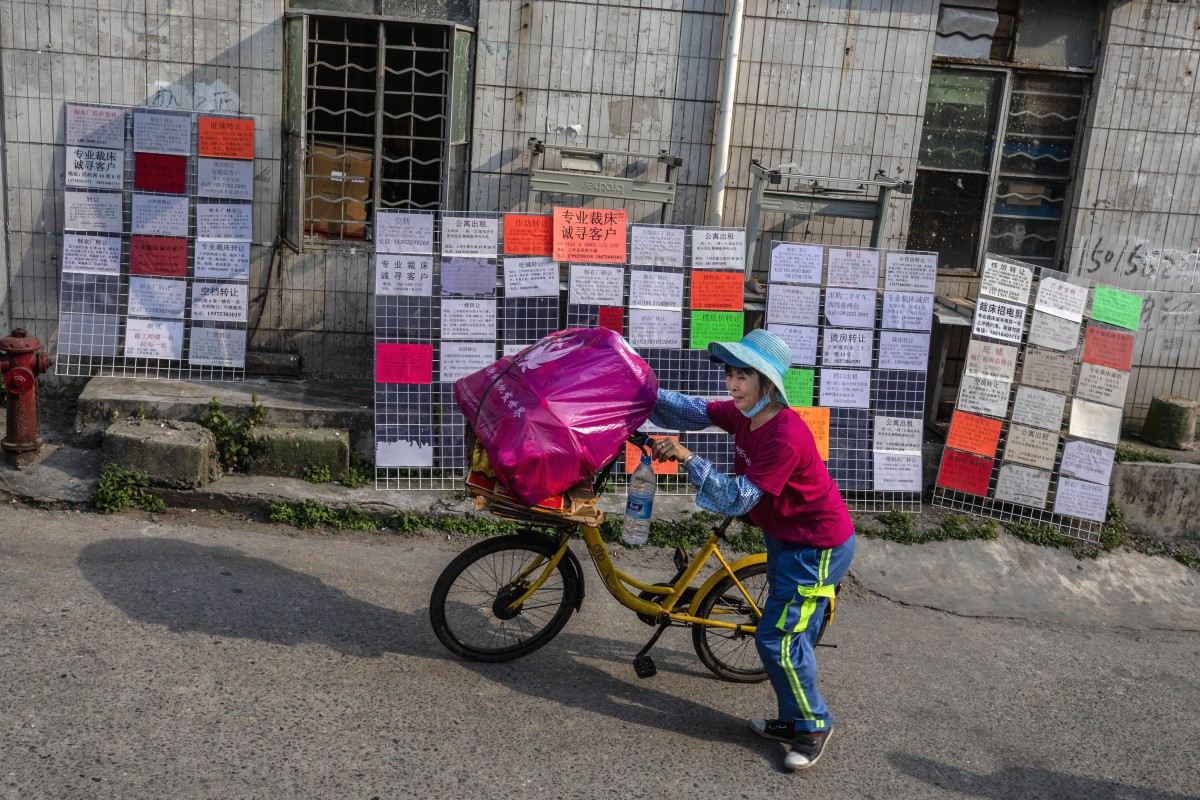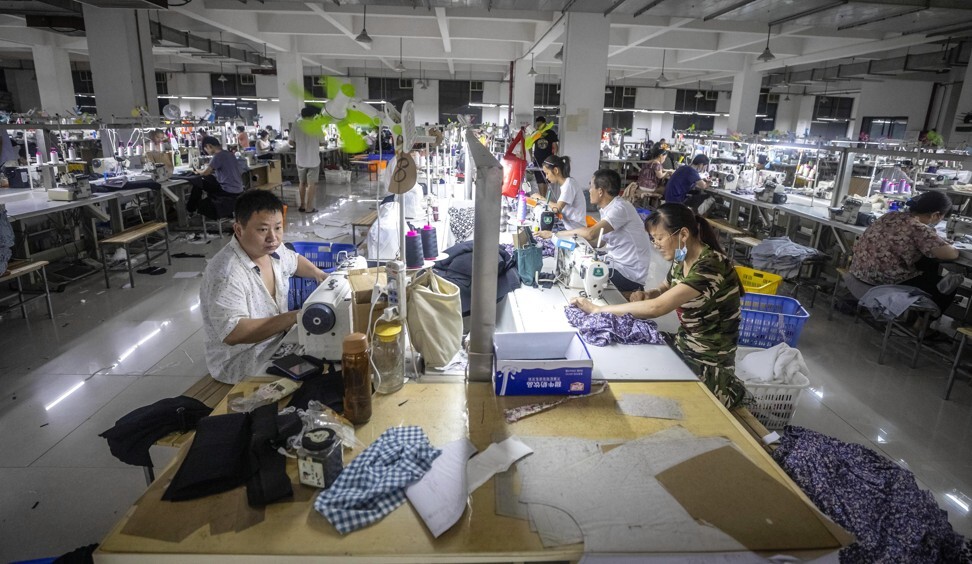Coronavirus has hit China’s migrant workers harder than Sars and the financial crisis, but worst yet to come
China’s army of 290 million migrant workers has been particularly hard hit by the pandemic, but most are unable to access unemployment support
Covid-19 is having a deeper impact on employment in China than the severe acute respiratory syndrome (Sars) outbreak and the global financial crisis
Cissy Zhou
Published: 25 May, 2020
https://www.scmp.com/economy/china-economy/article/3085904/coronavirus-has-hit-chinas-migrant-workers-harder-sars-and
VIDEOS AT THE END

A woman walks by a message boards filled with ads for jobs, flats to rent and business services in Little Hubei village of Guangzhou, Guangdong province. Photo: EPA-EFE
In early January, when a mysterious “new pneumonia” started to ripple across parts of China, domestic worker Zou Lan caught a cold.
Though authorities had yet to announce the unprecedented threat the coronavirus posed, her employer asked her to take some rest. She has been unable to return to work since.
China’s unemployment situation is a potential crisis for the Communist Party, whose ability to provide relief and jobs for people like Zou matter not just for arresting flagging growth, but also social stability.
Chinese students grapple with first economic downturn of their lives
14 May 2020


At China’s National People’s Congress, the annual parliamentary gathering that began in Beijing last week, officials omitted any mention of an annual gross domestic product (GDP) growth target for the first time, and reiterated employment was the government’s top priority.
But despite its importance, China’s real jobless picture is blurred. Research from Shandong-based Zhongtai Securities in late April put the real unemployment rate at 20.5 per cent, or some 70 million people out of work.
Already, the impact of the Covid-19 outbreak on employment in China is deeper than the severe acute respiratory syndrome (Sars) outbreak in 2002-03 and the global financial crisis in 2008, according to Li Tao, a founder of Beijing Social Work Development Centre for Facilitators, a non-governmental organisation that helps migrant workers.
The Sars outbreak didn’t lead to a global pandemic, and the financial crisis hit the export-oriented factories most but had limited impact on the service industryLi Tao
“The Sars outbreak didn’t lead to a global pandemic, and the financial crisis hit the export-oriented factories most but had limited impact on the service industry,” Li said. “But Covid-19 has severely weakened global demand and the service sector.”
The effect of Sars on China’s growth proved short-lived as the Chinese economy entered a boom cycle from the summer of 2003, when the outbreak was brought under control. The global financial crisis, meanwhile, caused some 20 million migrant workers – mainly in coastal areas – to lose their jobs.
In the latest wave of unemployment, China’s migrant workers are not only facing job losses but deep cuts to their salaries. Nearly 80 per cent of them had returned to work as early as April, though most had their wages reduced, according to a survey by Li’s organisation last month.
China’s domestic economic recovery may encourage consumer spending and create more jobs in coming months, especially temporary work in decoration and service industries, Li said.
It has not reached the inflection point yet as most the factories are still working on the orders that were placed before the pandemicLi Tao
“However, it is still too early to tell the full picture of the impact,” he said. “It has not reached the inflection point yet as most the factories are still working on the orders that were placed before the pandemic.”
Wang Guang is one of the lucky ones that held onto his job at a plant operated by a US contract manufacturer in Zhuhai.
But the 39-year-old’s salary has been slashed by about 40 per cent, from more than 4,000 yuan (US$561) a month to less than 3,000 yuan, despite his 10 years of service at the company.
The electronics factory suspended part of its manufacturing operation last year after it pared down business deals with a major Chinese telecoms giant.
The slowdown in production due to lack of orders has meant reduced work hours for Wang, who usually sent back 2,000 yuan each month to his wife and two kids, who live in his hometown, a small village in central China.
Coronavirus backlash further fraying China’s ties to global economy
Migrant workers typically rely on overtime work to increase real income to a level of at least 4,000 yuan, about double the average minimum wage.
“We are currently working on the orders that were placed before the virus, I don’t know what will happen when we finish these orders,” Wang said.
In February, when China was worst hit by the deadly virus, Wang and his colleagues were asked to mop the factory floor because there was so little work to do.
The pay cut prompted many of Wang’s younger colleagues to leave, and his department has gone from a 200-strong workforce to just a few dozen, with most that have stayed in their 50s.

Many of China’s migrant workers rely on overtime work to supplment their wages. Photo: EPA-EFE
China’s labour law stipulates that any work performed after the 8-hour workday limit must be paid at 1.5 times the employee’s normal working wage, and overtime hours at weekends must be compensated at double the hourly rate.
While others have left to find factories with more overtime hours, Wang decided to stay because looking for a new job would be “a waste of time” when most firms were downsizing.
In the past, young migrant workers were able to hop from factory jobs to the rapidly expanding services industry. But service jobs are also drying up during the pandemic.
An early April survey of 5,451 restaurants conducted by China Hotel Association showed that about 80 per cent had reopened, but average revenue was less than a fifth compared with a year earlier, forcing more lay-offs than new hires.
Migrant workers have been a driving force in China’s infrastructure boom and rapid urbanisation since the 1980s. Remittances from cities to rural areas also help narrow the wealth gap and lift people out of absolute poverty – one of President Xi Jinping’s top policy goals.
“When disaster occurs, some migrant workers would choose to go back to their hometown to reduce living costs. However, as long as there are any chances in the city, 80 per cent of the migrant workers will go back to the city, because there are no jobs in their rural hometown,” said Li, from Beijing Social Work Development Centre for Facilitators.
FOR MORE ON THIS SERIES
https://series.scmp.com/grim-outlook-chinese-unemployment/

China’s army of 290 million migrant workers has been particularly hard hit by the pandemic, but most are unable to access unemployment support
Covid-19 is having a deeper impact on employment in China than the severe acute respiratory syndrome (Sars) outbreak and the global financial crisis
Cissy Zhou
Published: 25 May, 2020
https://www.scmp.com/economy/china-economy/article/3085904/coronavirus-has-hit-chinas-migrant-workers-harder-sars-and
VIDEOS AT THE END

A woman walks by a message boards filled with ads for jobs, flats to rent and business services in Little Hubei village of Guangzhou, Guangdong province. Photo: EPA-EFE
In early January, when a mysterious “new pneumonia” started to ripple across parts of China, domestic worker Zou Lan caught a cold.
Though authorities had yet to announce the unprecedented threat the coronavirus posed, her employer asked her to take some rest. She has been unable to return to work since.
Penniless and with three kids to support, the single mother – who had worked in Nanjing for more than 10 years – has been trying to find a job for four months. After multiple failed job applications, she is getting increasingly desperate.
“My former employer treated me well. She asked me to wait for her call in January, telling me that they would like me to go back when the outbreak is brought under control. I’ve been waiting for months and am getting pessimistic about it,” the 41-year-old said.
Like most of China’s 290 million migrant workers, her jobless status has not been recorded in China’s official unemployment statistics and she has been excluded from state support.
Compared to the United States’ record-high unemployment rate of 14.7 per cent in April, China’s official jobless rate was 6 per cent in the same month, up from 5.9 per cent in March.
Only about 2.3 million people had received unemployment benefits by the end of March, a fraction of the estimated tens of millions who have lost their jobs as the pandemic has lashed the world’s second largest economy.
“My former employer treated me well. She asked me to wait for her call in January, telling me that they would like me to go back when the outbreak is brought under control. I’ve been waiting for months and am getting pessimistic about it,” the 41-year-old said.
Like most of China’s 290 million migrant workers, her jobless status has not been recorded in China’s official unemployment statistics and she has been excluded from state support.
Compared to the United States’ record-high unemployment rate of 14.7 per cent in April, China’s official jobless rate was 6 per cent in the same month, up from 5.9 per cent in March.
Only about 2.3 million people had received unemployment benefits by the end of March, a fraction of the estimated tens of millions who have lost their jobs as the pandemic has lashed the world’s second largest economy.
China’s unemployment situation is a potential crisis for the Communist Party, whose ability to provide relief and jobs for people like Zou matter not just for arresting flagging growth, but also social stability.
Chinese students grapple with first economic downturn of their lives
14 May 2020

At China’s National People’s Congress, the annual parliamentary gathering that began in Beijing last week, officials omitted any mention of an annual gross domestic product (GDP) growth target for the first time, and reiterated employment was the government’s top priority.
But despite its importance, China’s real jobless picture is blurred. Research from Shandong-based Zhongtai Securities in late April put the real unemployment rate at 20.5 per cent, or some 70 million people out of work.
Already, the impact of the Covid-19 outbreak on employment in China is deeper than the severe acute respiratory syndrome (Sars) outbreak in 2002-03 and the global financial crisis in 2008, according to Li Tao, a founder of Beijing Social Work Development Centre for Facilitators, a non-governmental organisation that helps migrant workers.
The Sars outbreak didn’t lead to a global pandemic, and the financial crisis hit the export-oriented factories most but had limited impact on the service industryLi Tao
“The Sars outbreak didn’t lead to a global pandemic, and the financial crisis hit the export-oriented factories most but had limited impact on the service industry,” Li said. “But Covid-19 has severely weakened global demand and the service sector.”
The effect of Sars on China’s growth proved short-lived as the Chinese economy entered a boom cycle from the summer of 2003, when the outbreak was brought under control. The global financial crisis, meanwhile, caused some 20 million migrant workers – mainly in coastal areas – to lose their jobs.
In the latest wave of unemployment, China’s migrant workers are not only facing job losses but deep cuts to their salaries. Nearly 80 per cent of them had returned to work as early as April, though most had their wages reduced, according to a survey by Li’s organisation last month.
China’s domestic economic recovery may encourage consumer spending and create more jobs in coming months, especially temporary work in decoration and service industries, Li said.
It has not reached the inflection point yet as most the factories are still working on the orders that were placed before the pandemicLi Tao
“However, it is still too early to tell the full picture of the impact,” he said. “It has not reached the inflection point yet as most the factories are still working on the orders that were placed before the pandemic.”
Wang Guang is one of the lucky ones that held onto his job at a plant operated by a US contract manufacturer in Zhuhai.
But the 39-year-old’s salary has been slashed by about 40 per cent, from more than 4,000 yuan (US$561) a month to less than 3,000 yuan, despite his 10 years of service at the company.
The electronics factory suspended part of its manufacturing operation last year after it pared down business deals with a major Chinese telecoms giant.
The slowdown in production due to lack of orders has meant reduced work hours for Wang, who usually sent back 2,000 yuan each month to his wife and two kids, who live in his hometown, a small village in central China.
Coronavirus backlash further fraying China’s ties to global economy
Migrant workers typically rely on overtime work to increase real income to a level of at least 4,000 yuan, about double the average minimum wage.
“We are currently working on the orders that were placed before the virus, I don’t know what will happen when we finish these orders,” Wang said.
In February, when China was worst hit by the deadly virus, Wang and his colleagues were asked to mop the factory floor because there was so little work to do.
The pay cut prompted many of Wang’s younger colleagues to leave, and his department has gone from a 200-strong workforce to just a few dozen, with most that have stayed in their 50s.

Many of China’s migrant workers rely on overtime work to supplment their wages. Photo: EPA-EFE
China’s labour law stipulates that any work performed after the 8-hour workday limit must be paid at 1.5 times the employee’s normal working wage, and overtime hours at weekends must be compensated at double the hourly rate.
While others have left to find factories with more overtime hours, Wang decided to stay because looking for a new job would be “a waste of time” when most firms were downsizing.
In the past, young migrant workers were able to hop from factory jobs to the rapidly expanding services industry. But service jobs are also drying up during the pandemic.
An early April survey of 5,451 restaurants conducted by China Hotel Association showed that about 80 per cent had reopened, but average revenue was less than a fifth compared with a year earlier, forcing more lay-offs than new hires.
Migrant workers have been a driving force in China’s infrastructure boom and rapid urbanisation since the 1980s. Remittances from cities to rural areas also help narrow the wealth gap and lift people out of absolute poverty – one of President Xi Jinping’s top policy goals.
“When disaster occurs, some migrant workers would choose to go back to their hometown to reduce living costs. However, as long as there are any chances in the city, 80 per cent of the migrant workers will go back to the city, because there are no jobs in their rural hometown,” said Li, from Beijing Social Work Development Centre for Facilitators.
FOR MORE ON THIS SERIES
https://series.scmp.com/grim-outlook-chinese-unemployment/
No comments:
Post a Comment